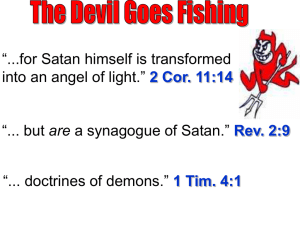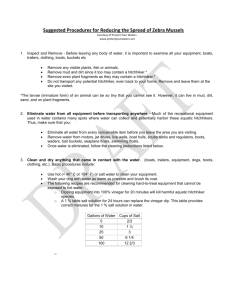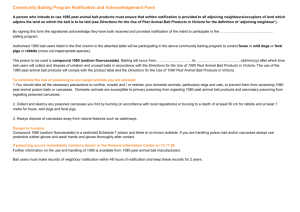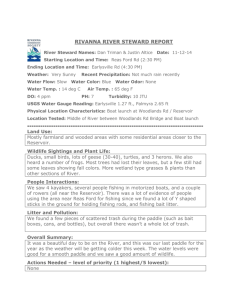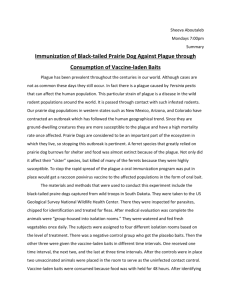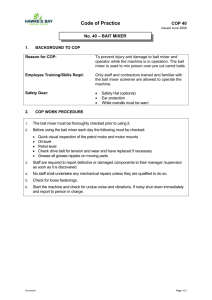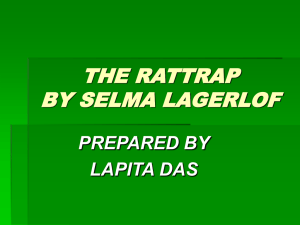1. summary - Animal Control Products
advertisement
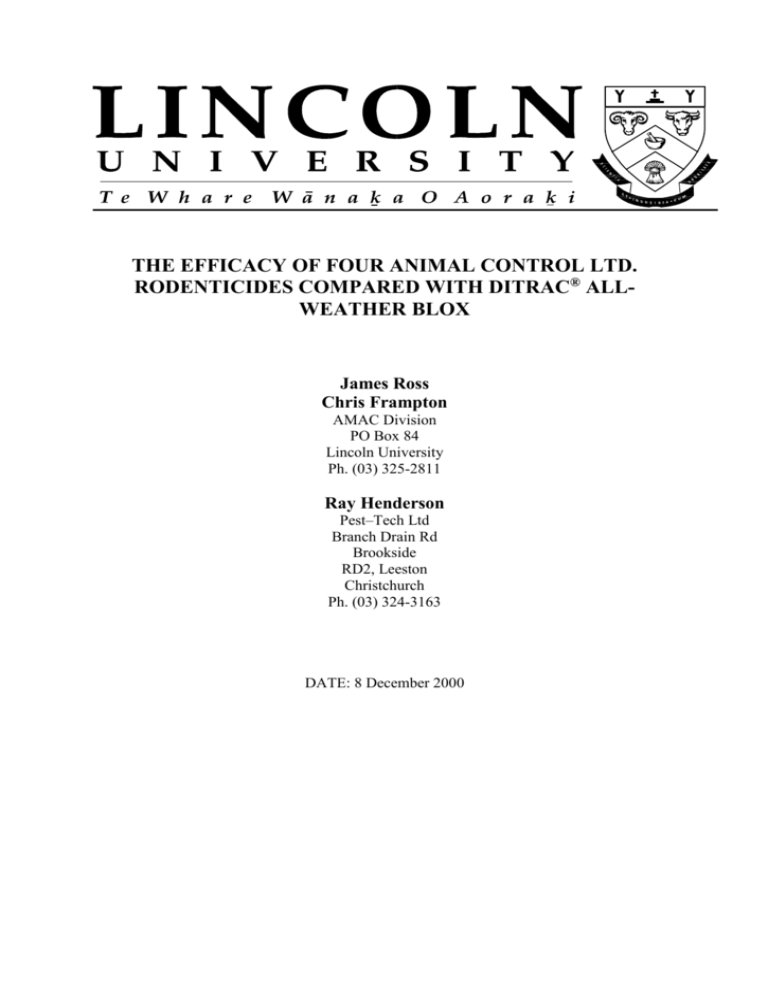
THE EFFICACY OF FOUR ANIMAL CONTROL LTD. RODENTICIDES COMPARED WITH DITRAC® ALLWEATHER BLOX James Ross Chris Frampton AMAC Division PO Box 84 Lincoln University Ph. (03) 325-2811 Ray Henderson Pest–Tech Ltd Branch Drain Rd Brookside RD2, Leeston Christchurch Ph. (03) 324-3163 DATE: 8 December 2000 2 CONTENTS 1. Summary …………………………………………………………………… 3 2. Introduction …………………………………………………………………… 5 3. Objective …………………………………………………………………… 5 4. Methods …………………………………………………………………… 5 5. Results …………………………………………………………………… 6 6. Conclusions ………………………………………………………………..….. 9 7. References …………………………………………………………………… 10 8. Appendix 1 …………………………………………………………………… 12 1. SUMMARY 1.1 Project and Client This report summarises research that evaluated the palatability and efficacy of four rodenticides supplied by Animal Control Products Ltd. (ACP; containing brodifacoum) and Ditrac ® All-Weather Blox (containing diphacinone). The work was undertaken by Ray Henderson (Pest-Tech), James Ross (Lincoln University) and Chris Frampton (Lincoln University) and was funded by ACP. 1.2 Objective To compare the relative palatability and efficacy of four ACP rodenticide formulations with Ditrac All-Weather Blox (as an industry ‘standard’; see table below for bait abbreviations). Trial Baits Pestoff Rodent Bait Pestoff Rodent Bait with additive Pestoff Rodent Blocks Pestoff Rodent Blocks with additive Ditrac Blox (Manufactured by Bell Labs) Abbr. Code P1 P2 B1 B2 DITRAC The additive included in the P2 and B2 baits was an experimental compound thought to increase the palatability of baits to rodents. 1.3 Methods One hundred and twenty healthy, active and sexually mature rats (Rattus norvegicus) were randomly allocated into six treatment groups (including a control group) balanced for weight and sex. 3 The relative palatability of the rodenticide formulations was compared using a standard ‘two-choice’ test, in which the rats were given paired-food trays containing 100 g of rodenticide and 100 g of the ‘challenge diet’ for seven days. Mortality was assessed every 24 hours. 1.4 Results The P1 and P2 and baits were significantly more palatable than the B1 and Ditrac Blox bait types on the first day of exposure. There was no significant difference in the palatability of the P1 and P2 baits. The P1 and P2 baits were consistently more palatable (range: 7-32%) than the B1, B2 and Ditrac Blox baits (range: 5-13%). The palatability of baits did not increase over time. Over the seven days of the trial, rats consumed two-to-three times as much P1 or P2 as B1, B2 or Ditrac Blox and this affected the efficacy of the baits. The P1 and P2 baits had the highest rates of mortality (98% killed at 7 days) with the B1 and B2 baits killing 83% of the rats over 7 days. The Ditrac Blox had the lowest rate of mortality (40% over 7 days) and this difference was significant when compared to the P1, P2 and B1 bait types. For rats that consumed a lethal amount of bait, death occurred within 3-11 days. The rats consuming P1 and P2 bait died on average five days after bait was first applied with last animal dying on the ninth day (39 out of 40 rats killed). In contrast, the time to death generally took longer for the other three bait types, most likely due to the low bait consumption and the lower toxicity of diphacinone (42 of 60 rats killed). 1.5 Conclusions The P1 and P2 baits supplied were the most efficacious and humane bait types tested in this study. The palatability and rates of consumption of ACP produced block baits B1 and B2 were not significantly different from Ditrac Blox although B1 and B2 baits proved to be more efficacious. The incorporation of additive into the P2 and B2 baits appeared to have no significant affect on bait palatability or bait consumption by rats. 4 2. INTRODUCTION Animal Control Products Limited (ACP) is New Zealand’s leading supplier of vertebrate pesticide baits; primarily for the control of the brushtail possum (Trichosurus vulpecula). There is currently a large domestic market for these products with in excess of NZD$50m spent annually on possum control by the Animal Health Board and Department of Conservation (Eason et al., 1996). In recent years, ACP has also become internationally recognised as a leading manufacturer of bait to eradicate rodents (Rattus spp.) on offshore islands. For example, rodent bait manufactured by ACP (primarily containing brodifacoum) has been successfully used on Flat Island (Mauritius), Round Island (French Territories) and Bird Island (Seychelles; ACP, 2000). Whilst this work is important and profitable, there are concerns regarding the long-term use of some toxicants in the New Zealand market (e.g. bait containing 1080; Eason, 1996). Accordingly, ACP has expanded its product range into short field life and long field life rodenticides that can be used to restore ecological values to offshore islands, protect farm structures and bulk-food stores. Rodents cause severe economic losses to agriculture worldwide (i.e., consumption/spoiling of foodstuffs) and the potential export market for proven rodenticides particularly with the United States Environmental Protection Agency (EPA) approval is considerable (Johnson and Prescott, 1994). Approximately 3 years ago, ACP developed Pestoff Rodent Bait (pellets) and Pestoff Rodent Blocks both containing brodifacoum as the active ingredient. Bait containing brodifacoum had previously been registered by the Pesticides Board in New Zealand and by the EPA for use around farm structures, domestic dwellings, uncultivated agriculture areas, inside transport vehicles, commercial transportation facilities, industrial area, sewerage systems, aircraft, ships, boats, railway cars and food processing, handling and storage areas (EPA, 1998). The objective of this research was to compare the efficacy of the ACP baits, and the baits containing an additive, with a long established rodenticide. One of the main international manufacturers of rodenticide products is Bell Laboratories, Inc. and they produce a long-life rodenticide bait called Ditrac® All-Weather Blox. This rodenticide contains the first generation anticoagulant diphacinone and is currently authorised by EPA for use in meat plants, poultry plants, around homes, farms and industrial buildings (Bell, 2000). ACP’s Pestoff Rodent Block has similar approvals in New Zealand for use in meat, fish, game and dairy processing areas. 3. OBJECTIVE To compare the relative palatability and efficacy of four ACP rodenticide formulations with Ditrac All-Weather Blox. 4. METHODS Bait used in the trial ACP supplied two cereal-pellet baits (labelled P1 and P2) and two cereal-block baits (labelled B1 and B2). All ACP baits contained the anticoagulant brodifacoum at a nominal concentration of 20 mg kg-1. The Ditrac All-Weather Blox (labelled Ditrac) was manufactured by Bell Laboratories, Inc. and contained the anticoagulant diphacinone at a nominal concentration of 50 mg kg-1. Animal Husbandry 5 One hundred and twenty healthy, active and sexually mature rats (Rattus norvegicus) were randomly allocated into six treatment groups (including a control group) balanced for weight and sex (mean body weight 357.70 g + 33.27 SD). All animals were weighed on the first night and then housed in individual cages (conforming to EPA Guidelines; Buckle and Smith, 1994) at the Pest-Tech animal facility. These animals were then weighed daily and only animals with stable or increasing body weights after seven days of captivity were used in trials. During the acclimatisation all rats had ad libitum access to water and pelleted rat food. Bait Palatability The relative palatability of the rodenticide formulations was compared using a standard ‘twochoice’ test (Grote and Brown, 1971), in which the rats were given paired-food trays containing 100 g of rodenticide and 100 g of a non-toxic control (the EPA-approved non-toxic ‘challenge’ diet; EPA, 1982). Palatability was calculated each day as the percentage of test bait eaten relative to the total bait eaten (i.e. test + control bait). Accordingly, a value of 50% demonstrates that the test bait is of equal palatability to the control. Bodyweight was also monitored daily during this phase of the trial and any animals losing more than 20% of their initial bodyweight were euthanised with CO2 (OECD, 1987) and discarded from the trial. Typically weight loss was negligible and no animals were withdrawn from the experiment. Animal Behaviour and Mortality All animals were checked daily for any grossly abnormal behaviour such as paralysis, convulsions or self-mutilation. External signs of haemorrhaging were also recorded and all survivors were observed (on normal diet) for an additional 4 days post-trial. All remaining survivors were then euthanised and post-mortemed to check for signs of internal haemorrhaging. Data Analysis Initial palatability on day one, overall palatability, cumulative bait take and time to death were compared between bait types using one-way ANOVA. Pair-wise separation of bait types was performed, where the one-way ANOVA indicated significant differences, using Fishers LSD test. Mortality was compared between pairs of rodenticides using the χ2 test of independence. Ethics Approval This experiment was conducted with the approval of The Lincoln University Animal Ethics Committee (Approval No. # 868). 5. RESULTS Initial Bait Palatability All bait on day one had low initial palatability, relative to the challenge diet (range 9.9%28.1%). However, bait type had a highly significant influence on individual measures of palatability (F4, 95 = 2.54; P<0.05; Figure 1). LSD tests indicated that the P1 and P2 baits were 6 significantly more palatable than the B1 and Ditrac Blox bait types (P<0.05). There was no significant difference in the initial palatability of the P1 and P2 baits (P=0.916). b b P1 P2 Percentage palatability 40% 35% 30% a 25% ab a 20% 15% 10% 5% 0% B1 B2 Ditrac Bait Type Figure 1. Mean percentage palatability of each bait type with respect to the challenge diet after the first day of exposure (+ SE). Letters above the bars denote statistical difference at the =0.05 level of significance. Palatability over Time While the mean daily measures of palatability were variable (Figure 2) throughout the study, bait type significantly affected palatability (F4, 95=6.563, P<0.001). LSD tests indicated that the P1 and P2 baits were significantly more palatable (P<0.004) than the other three baits over the seven days of the trial. There was no significant difference in the palatability of the P1 and P2 baits (P=0.91). P2 P1 35% B1 Percentage palatability 30% B2 DITRAC 25% 20% 15% 10% 5% 0% 1 2 3 4 5 6 7 Days Figure 2. Mean palatability of each bait type with respect to the challenge diet over seven days of exposure. 7 Total and Cumulative Bait Take Analysis of bait consumption indicted that bait type had a highly significant influence on the total amount consumed by individual rats (F4, 94=5.607, P<0.001). LSD tests indicated the rats consumed significantly more of the P1 and P2 baits, when compared to the B1, B2 and Ditrac Blox baits (P<0.02; Figure 3). 40.00 P2 Mean cummulative bait consumption (g) 35.00 P1 B1 30.00 B2 25.00 Ditrac 20.00 15.00 10.00 5.00 0.00 1 2 3 4 Days 5 6 7 Figure 3. Mean cumulative consumption of five types of rodenticide bait during a 7-day period. Mortality Percentage mortality The B1, B2, P1 and P2 baits had the highest rates of mortality (range 70-100%; Figure 4). The Ditrac Blox (40%) had the lowest rate of mortality and this difference was significant when compared to the P1, P2 and B1 bait types (2 test, all P<0.05). The control group had 0% mortality throughout the trial. 100% 90% 80% 70% 60% 50% 40% 30% 20% 10% 0% B1 B2 Ditrac P1 P2 Bait type Figure 4. Percentage mortality of rats exposed to five types of rodenticides. 8 Time to Death Time to death varied between three and 11 days (Figure 5). Analysis of the mortality data indicated that the bait type had a significant influence on the time to death (F4, 76=2.787, P=0.05) with LSD tests indicating that rats consuming P1 and P2 baits died significantly faster than rats consuming Ditrac Blox (P<0.05). Percentage mortality 100% 50% P2 P1 B1 B2 Ditrac 0% 0 1 2 3 4 5 6 7 8 9 10 11 Time to death (days) Figure 5. Time to death in days for five types of rodenticides during a 7-day period (+ 95% CI). 6. CONCLUSIONS While daily measures of bait palatability for individual rats were variable, overall the P1 and P2 baits were more palatable than others tested. In contrast, the palatability of B1, B2 and Ditrac Blox bait remained consistently low and did not increase with repeated exposure to the bait (Figure 2). Consequently, rats consumed two-to-three times as much P1 or P2 bait as B1, B2 or Ditrac Blox. The low palatability of the Ditrac Blox was surprising as this bait has EPA approval. Diphacinone is marketed as a multiple-dose toxicant, with a recommended baiting period of not less than 10 days (Bell, 2000). Accordingly, it is feasible that the rats may require longer periods of exposure to diphacinone than the 7-day period used in this study. However, previous rodent research has demonstrated that the acceptance of novel bait usually peaks on the first day (following acclimatisation) and then drops to a minimum by test-day four (Buckle and Smith, 1994). This suggests that consumption of Ditrac Blox was unlikely to increase by exposing rats to bait for a longer period of time. This hypothesis is supported by an analysis of bait consumption amongst the Ditrac Blox survivors, which confirmed that consumption of the Ditrac Blox was not increasing over time (Appendix 1). Rats survived the Ditrac Blox treatment by avoiding the toxic bait in favour of the challenge diet. The analysis of bait consumption for the 11 Ditrac Blox survivors also indicated an average total consumption of only 2.7 g of bait. Diphacinone has lower toxicity (LD50 = 3.0 mg kg-1) than brodifacoum (LD50 = 0.3 mg kg-1) and the average total consumption of the survivors (2.7 g) is significantly less than the calculated LD50 of 15 g (with a toxic conc. of 50 mg kg-1) for a 250 g rat (Buckle and Smith, 1994). Not surprisingly, none of the Ditrac Blox survivors showed any sign of internal haemorrhaging when post-mortemed. While the B1 and B2 baits (containing brodifacoum) also had lower palatability than the P1 and P2 baits, they still killed more rats than the Ditrac Blox due to the higher brodifacoum toxicity. The 9 estimated LD50 of brodifacoum bait (with a toxic conc. of 20 mg kg-1) is only 3.75 g of bait for a 250 g rat. Accordingly, even when similar amounts of bait consumed (e.g. 3-4 g); baitcontaining brodifacoum will kill significantly more rats than bait containing diphacinone. For rats consuming a lethal dose, death occurs within 3-11 days of when baits are first applied. As detailed above, rats exposed to the P1 and P2 bait ate significantly more bait on first exposure. Accordingly, these rats ingested a lethal dose more quickly than rats exposed to the other bait types. The majority of the rats consuming P1 and P2 bait were dead within five days, with last animal dying on the ninth day (39 out of 40 rats killed). In contrast, it took longer for the other three bait types to kill rats (42 of 60 rats killed). Given this difference in the time to death, one could speculate that the P1 and P2 baits were the most humane. While humaneness is a subjective term, the ultimate goal of a rodenticide is to minimise pain, distress and discomfort during the killing of animals (Buckle and Smith, 1994). Accordingly, any bait that minimises the time to death should be considered as a more humane option. In conclusion, the P1 and P2 baits were more palatable and efficacious than the other three bait types. Whilst the P1 killed one more rats than P2, we were unable to identify any significant difference in the palatability or consumption of these two baits. Our results suggest that the P1 and P2 baits were more successful as a result of significantly higher bait palatability, which resulted in the rats consuming more toxicant over the seven days of feeding. The palatability of B1 and B2 baits was not significantly different from Ditrac Blox but they proved more efficacious due to their containing a more potent toxicant (brodifacoum). Bait containing additive (P2 and B2) appeared to be no more palatable overall than bait without the additive (P1 and B1). Anecdotal evidence from field operators suggests that pellet baits (P1 and P2) decay much more rapidly than block baits (B1, B2 and Ditrac) and as a consequence, P1 and P2 bait types may quickly become less palatable than the block baits when affected by a combination of warm temperatures, high humidity and rainfall. From this we would recommend that pellet bait types are best used where a rapid bait uptake is expected and that block baits are best used where longer term rodent control, without regular re-laying of baits, is sought. 7. REFERENCES Animal Control Products Ltd. (2000) Achievements: International, Internet web page: http://www.pestoff.co.nz. Bell Laboratories, Inc. (2000) Product Catalogue, Internet web page: http://www.belllabs.com. Buckle, A. P. and Smith, R. H. (Eds.) (1994) Rodent control methods: Chemicals, CAB International, London, U.K. Eason, C. T. (1996) In: Improving conventional control of possums, Miscellaneous Series 35. The Royal Society of New Zealand, Wellington, New Zealand, pp. 46-50. Eason, C. T., Warburton, B. and Gregory, N. (1996) In: Improving conventional control of possums, Miscellaneous Series 35. The Royal Society of New Zealand, Wellington, New Zealand, pp. 24-28. 10 Environmental Protection Agency (1982) Pesticide Assessment Guidelines, Subdivision G: Product Performance, United States Environmental Protection Agency, Washington, USA. Environmental Protection Agency (1998) R.E.D. Facts: Rodenticide Cluster, Internet web page: http:\\www.epa.gov. Grote, F. W. and Brown, R. T. (1971) Conditioned taste aversions: Two-stimulus tests are more sensitive than one-stimulus tests. Journal of Behavioural Research Methods and Instrumentation, 3, 311-312. Johnson, R. A. and Prescott, C. V. (1994) In: Rodent pests and their control. (Eds. Buckle, A. P. and R.H.) CAB International, London, U.K., pp. 161-179. Organisation for Economic Co-operation and Development (1987) Guidelines for testing of chemicals. Section 4 (Health Effects), Organisation for Economic Cooperation and Development, Paris. 11 8. APPENDIX 1 Mean Comsumption by survivors This Appendix details the mean consumption of Ditrac Blox bait by the rats that survived this treatment. As detailed above, the LD50 for a 250 g rat is 15 g and these survivors only consumed a mean total of 2.7 g after seven days of feeding. By the seventh day, these rats were consuming a mean total of less than 0.5 g and there is no evidence that they would have consumed a lethal dose with additional feeding (Figure 6). 1.4 1.2 1.0 0.8 0.6 0.4 0.2 0.0 1 2 3 4 Days 5 6 7 Figure 6. Mean consumption of bait by the Ditrac Blox survivors over a 7-day period.


